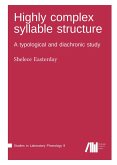Karen Guffey
Spanish Syllable Structure
Karen Guffey
Spanish Syllable Structure
- Broschiertes Buch
- Merkliste
- Auf die Merkliste
- Bewerten Bewerten
- Teilen
- Produkt teilen
- Produkterinnerung
- Produkterinnerung
The syllable is probably the most easily identifiable of all phonological units. Although a few scholars have questioned its existence, the real question involves its construction.
Andere Kunden interessierten sich auch für
![Highly complex syllable structure Highly complex syllable structure]() Shelece EasterdayHighly complex syllable structure39,99 €
Shelece EasterdayHighly complex syllable structure39,99 €![SYLLABLE & SEGMENT IN LATIN OSDHL 16 C SYLLABLE & SEGMENT IN LATIN OSDHL 16 C]() SenSYLLABLE & SEGMENT IN LATIN OSDHL 16 C150,99 €
SenSYLLABLE & SEGMENT IN LATIN OSDHL 16 C150,99 €![Tuimarishe Kiswahili Chetu / Building Proficiency in Kiswahili Tuimarishe Kiswahili Chetu / Building Proficiency in Kiswahili]() Lioba J. MoshiTuimarishe Kiswahili Chetu / Building Proficiency in Kiswahili50,99 €
Lioba J. MoshiTuimarishe Kiswahili Chetu / Building Proficiency in Kiswahili50,99 €![Bilingual Grammar of English-Spanish Syntax Bilingual Grammar of English-Spanish Syntax]() Sam HillBilingual Grammar of English-Spanish Syntax77,99 €
Sam HillBilingual Grammar of English-Spanish Syntax77,99 €![Metaphor, Culture, and Worldview Metaphor, Culture, and Worldview]() Dilin LiuMetaphor, Culture, and Worldview69,99 €
Dilin LiuMetaphor, Culture, and Worldview69,99 €![Man and Message Man and Message]() Kathleen CallowMan and Message96,99 €
Kathleen CallowMan and Message96,99 €![Handbook of Spanish-English Translation Handbook of Spanish-English Translation]() Lucía V. ArandaHandbook of Spanish-English Translation50,99 €
Lucía V. ArandaHandbook of Spanish-English Translation50,99 €-
-
-
The syllable is probably the most easily identifiable of all phonological units. Although a few scholars have questioned its existence, the real question involves its construction.
Produktdetails
- Produktdetails
- Verlag: University Press of America
- Seitenzahl: 178
- Erscheinungstermin: 5. April 2002
- Englisch
- Abmessung: 216mm x 140mm x 10mm
- Gewicht: 232g
- ISBN-13: 9780761822660
- ISBN-10: 0761822666
- Artikelnr.: 22371518
- Herstellerkennzeichnung
- Libri GmbH
- Europaallee 1
- 36244 Bad Hersfeld
- gpsr@libri.de
- Verlag: University Press of America
- Seitenzahl: 178
- Erscheinungstermin: 5. April 2002
- Englisch
- Abmessung: 216mm x 140mm x 10mm
- Gewicht: 232g
- ISBN-13: 9780761822660
- ISBN-10: 0761822666
- Artikelnr.: 22371518
- Herstellerkennzeichnung
- Libri GmbH
- Europaallee 1
- 36244 Bad Hersfeld
- gpsr@libri.de
Karen Guffey is Assistant Professor of Spanish, Gordon College.
Chapter 1 Preface
Chapter 2 Chapter 1-Introduction: Theories of the syllable
Chapter 3 Sound change
Chapter 4 Sonority/strength scales
Chapter 5 Data
Chapter 6 Chapter 2 - Syllable Division: Standard syllabification
Chapter 7 Division according to sonority value
Chapter 8 Markedness
Chapter 9 Chapter 3-The Evolution of Latin to Spanish: Theories of
direction
Chapter 10 Loss of segments
Chapter 11 Addition of segments
Chapter 12 Miscellaneous changes
Chapter 13 Chapter 4-Conclusions
Chapter 14 Chapter 5-Mexican Spanish
Chapter 15 Introduction
Chapter 16 The sonority hierarchy
Chapter 17 Rate of occurance
Chapter 18 Modern Standard Spanish vs. the Mexican dialect
Chapter 19 Summary
Chapter 20 Chapter 6-Tudancan Spanish: Introduction
Chapter 21 The sonority hierarchy
Chapter 22 Rate of occurence
Chapter 23 Modern Standard Spanish vs. the Tudancan dialect
Chapter 24 Summary
Chapter 25 Chaper 7-Colombian Spanish: Introduction
Chapter 26 The sonority hierarchy
Chapter 27 Rate of occurrence
Chapter 28 Modern Standard Spanish vs the Colombian dialect
Chapter 29 Summary
Chapter 30 Chapter 8-Dominican Spanish: Introduction
Chapter 31 The sonority hierarchy
Chapter 32 Rate of occurrence
Chapter 33 Modern Standard Spanish vs. the Dominican dialect
Chapter 34 Summary
Chapter 35 Chapter 9-Conclusions
Chapter 36 Bibliography
Chapter 37 Index
Chapter 2 Chapter 1-Introduction: Theories of the syllable
Chapter 3 Sound change
Chapter 4 Sonority/strength scales
Chapter 5 Data
Chapter 6 Chapter 2 - Syllable Division: Standard syllabification
Chapter 7 Division according to sonority value
Chapter 8 Markedness
Chapter 9 Chapter 3-The Evolution of Latin to Spanish: Theories of
direction
Chapter 10 Loss of segments
Chapter 11 Addition of segments
Chapter 12 Miscellaneous changes
Chapter 13 Chapter 4-Conclusions
Chapter 14 Chapter 5-Mexican Spanish
Chapter 15 Introduction
Chapter 16 The sonority hierarchy
Chapter 17 Rate of occurance
Chapter 18 Modern Standard Spanish vs. the Mexican dialect
Chapter 19 Summary
Chapter 20 Chapter 6-Tudancan Spanish: Introduction
Chapter 21 The sonority hierarchy
Chapter 22 Rate of occurence
Chapter 23 Modern Standard Spanish vs. the Tudancan dialect
Chapter 24 Summary
Chapter 25 Chaper 7-Colombian Spanish: Introduction
Chapter 26 The sonority hierarchy
Chapter 27 Rate of occurrence
Chapter 28 Modern Standard Spanish vs the Colombian dialect
Chapter 29 Summary
Chapter 30 Chapter 8-Dominican Spanish: Introduction
Chapter 31 The sonority hierarchy
Chapter 32 Rate of occurrence
Chapter 33 Modern Standard Spanish vs. the Dominican dialect
Chapter 34 Summary
Chapter 35 Chapter 9-Conclusions
Chapter 36 Bibliography
Chapter 37 Index
Chapter 1 Preface
Chapter 2 Chapter 1-Introduction: Theories of the syllable
Chapter 3 Sound change
Chapter 4 Sonority/strength scales
Chapter 5 Data
Chapter 6 Chapter 2 - Syllable Division: Standard syllabification
Chapter 7 Division according to sonority value
Chapter 8 Markedness
Chapter 9 Chapter 3-The Evolution of Latin to Spanish: Theories of
direction
Chapter 10 Loss of segments
Chapter 11 Addition of segments
Chapter 12 Miscellaneous changes
Chapter 13 Chapter 4-Conclusions
Chapter 14 Chapter 5-Mexican Spanish
Chapter 15 Introduction
Chapter 16 The sonority hierarchy
Chapter 17 Rate of occurance
Chapter 18 Modern Standard Spanish vs. the Mexican dialect
Chapter 19 Summary
Chapter 20 Chapter 6-Tudancan Spanish: Introduction
Chapter 21 The sonority hierarchy
Chapter 22 Rate of occurence
Chapter 23 Modern Standard Spanish vs. the Tudancan dialect
Chapter 24 Summary
Chapter 25 Chaper 7-Colombian Spanish: Introduction
Chapter 26 The sonority hierarchy
Chapter 27 Rate of occurrence
Chapter 28 Modern Standard Spanish vs the Colombian dialect
Chapter 29 Summary
Chapter 30 Chapter 8-Dominican Spanish: Introduction
Chapter 31 The sonority hierarchy
Chapter 32 Rate of occurrence
Chapter 33 Modern Standard Spanish vs. the Dominican dialect
Chapter 34 Summary
Chapter 35 Chapter 9-Conclusions
Chapter 36 Bibliography
Chapter 37 Index
Chapter 2 Chapter 1-Introduction: Theories of the syllable
Chapter 3 Sound change
Chapter 4 Sonority/strength scales
Chapter 5 Data
Chapter 6 Chapter 2 - Syllable Division: Standard syllabification
Chapter 7 Division according to sonority value
Chapter 8 Markedness
Chapter 9 Chapter 3-The Evolution of Latin to Spanish: Theories of
direction
Chapter 10 Loss of segments
Chapter 11 Addition of segments
Chapter 12 Miscellaneous changes
Chapter 13 Chapter 4-Conclusions
Chapter 14 Chapter 5-Mexican Spanish
Chapter 15 Introduction
Chapter 16 The sonority hierarchy
Chapter 17 Rate of occurance
Chapter 18 Modern Standard Spanish vs. the Mexican dialect
Chapter 19 Summary
Chapter 20 Chapter 6-Tudancan Spanish: Introduction
Chapter 21 The sonority hierarchy
Chapter 22 Rate of occurence
Chapter 23 Modern Standard Spanish vs. the Tudancan dialect
Chapter 24 Summary
Chapter 25 Chaper 7-Colombian Spanish: Introduction
Chapter 26 The sonority hierarchy
Chapter 27 Rate of occurrence
Chapter 28 Modern Standard Spanish vs the Colombian dialect
Chapter 29 Summary
Chapter 30 Chapter 8-Dominican Spanish: Introduction
Chapter 31 The sonority hierarchy
Chapter 32 Rate of occurrence
Chapter 33 Modern Standard Spanish vs. the Dominican dialect
Chapter 34 Summary
Chapter 35 Chapter 9-Conclusions
Chapter 36 Bibliography
Chapter 37 Index








